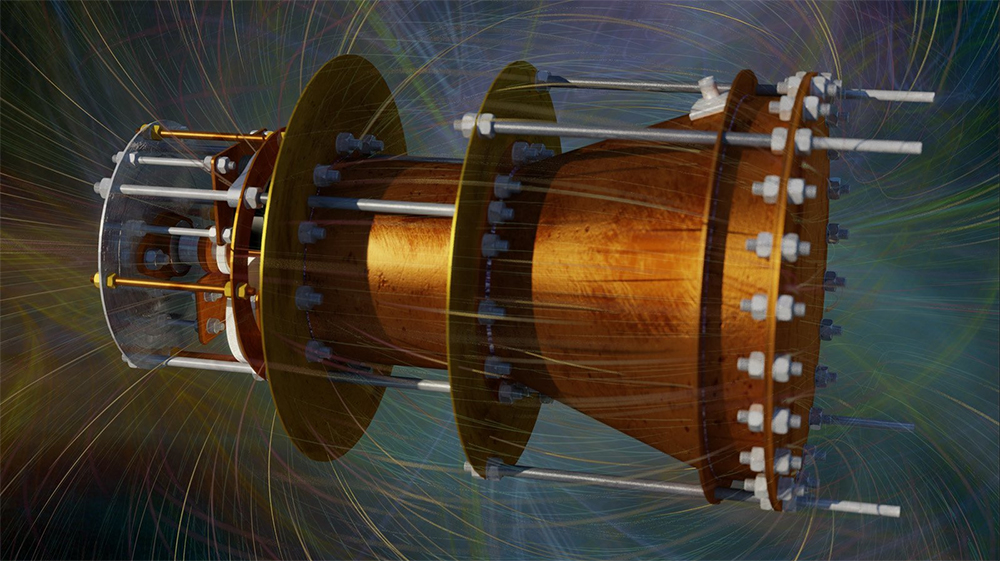Impossible EmDrive engine, Unruh effect, photons and inertia: an attempt to explain the incomprehensible

An English scientist from the University of Plymouth, Mike McCulloch [Mike McCulloch] in his work tried to explain the principle of the "impossible" engine EmDrive , which for several years baffled specialists. For this, the scientist had to give an explanation to such a fundamental concept of physics as inertia.
The EmDrive engine was invented in the early 2000s by British engineer Roger Scheuer. He presented his idea of a motor to the public, essentially consisting of a metallic truncated cone and a magnetron. According to his calculations, electromagnetic waves reflected inside the structure should create thrust without any reactive components.
')
Naturally, he was ridiculed, since the law of conservation of momentum does not allow the creation of such devices. But, starting in 2008 and the experience of Chinese scientists, and then - a few enthusiastic engineers, and ending with the experiences of respected engineers from NASA, more and more evidence is accumulating that this strange engine is working.
So far, the scientific world is not in a hurry with conclusions - just as the fact that the engine is working is not considered to be unconditionally confirmed, there are no generally accepted explanations for this fact. Makaloh proposes to use for this purpose such an exotic effect as Unruh radiation .
From school it is known that all objects with masses have such a property as inertia. Mass is even called the measure of inertia - this is the ability of bodies to resist attempts to change their speed or direction of motion. Or, in other words, the property of bodies to remain in some reference systems in a state of rest or uniform rectilinear motion in the absence or with mutual compensation of external influences.
But why does it arise? There is no answer to this question yet. Makaloh recalled the Unruh effect, named after Bill Unruh of the University of British Columbia, who discovered it in 1976.
Unruh showed that the concept of a vacuum depends on how the observer moves through space-time. If only a vacuum is around a stationary observer, then an accelerating observer will see around him many particles that are in thermodynamic equilibrium, that is, a warm gas. Thus, the vacuum temperature in the reference frame of a particle moving with a standard terrestrial gravitational acceleration of 9.81 m / s² will be calculated to be 4 * 10 −20 K.
In fact, after the opening of the Unruh, one can speak of a vacuum only with respect to some object. If the observer moves with acceleration, he observes around himself thermal radiation, or more precisely, black body radiation. But Makalokh believes that inertia is the pressure of this radiation on an accelerating body.
According to his calculations, with very small accelerations, the wavelength of the Unruh radiation is so large that it exceeds the size of the observed Universe. Therefore, inertia does not increase continuously, but is quantized. Surprisingly, this strange theory very well explains another incomprehensible effect - the transit anomalies.
The transit anomaly is an unexpected increase in energy during the gravitational maneuvers of spacecraft near the Earth. This anomaly was observed as Doppler frequency drift in the S-band and X-band and long-distance telemetry. All this together caused a significant unplanned increase in speed up to 13 mm / s during flyovers.
This anomaly was observed in 1990 with the passage of the Galileo spacecraft, created for the study of Jupiter and its satellites (speed increase by 4 mm / s); in 1998, the spacecraft NEAR Shoemaker, sent in 1996 to the asteroid Eros (speed increase by 13 mm / s); in 1999, Cassini (at 0.11 mm / s); in 2005, the Rosetta (at 2 mm / s).
Makaloh thinks that these sudden jumps occurred exactly when the acceleration increased, and the Unruh wavelength became rather small - at that moment the spacecraft experienced a speed jump. The Casimir effect works in a similar way.
Further explanation Makaloh become even more interesting: it assumes the presence of photons of inertial mass. And since photons experience reflection inside the EmDrive body, they also experience inertia. Only the wavelengths of Unruh radiation in this case will be extremely small. So small that they can fit in a conical motor housing.
And if it turns out that the Unruh waves that do not fit in its narrow part are placed in the wide part of the cone, then the inertia of photons, reflected in all directions, should change. And to save momentum, the system must create cravings. Makalokh conducted the calculations, and found out that his theory is consistent with the values of thrust obtained in the experiments (at least in the order of magnitude).
The most interesting thing is that his calculations can be checked in the next experiment with EmDrive. If he is right, then, firstly, placing the dielectric inside the engine cavity should increase the thrust force. Secondly, a change in the frequency of the photons or the geometry of the engine must change the thrust, up to a change in direction.
If this theory seems somewhat bold, if only because of the unusual assumptions contained in it, then there are still no other acceptable theories explaining EmDrive’s work. Who knows, maybe the work of an unusual engine can only be explained by an unusual theory?
Source: https://habr.com/ru/post/372135/
All Articles